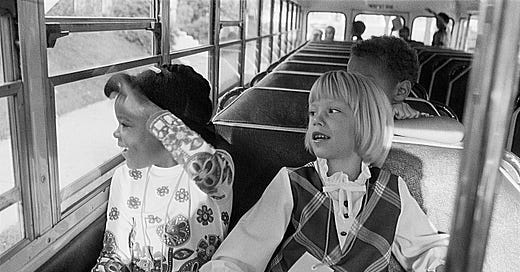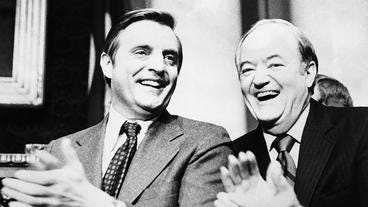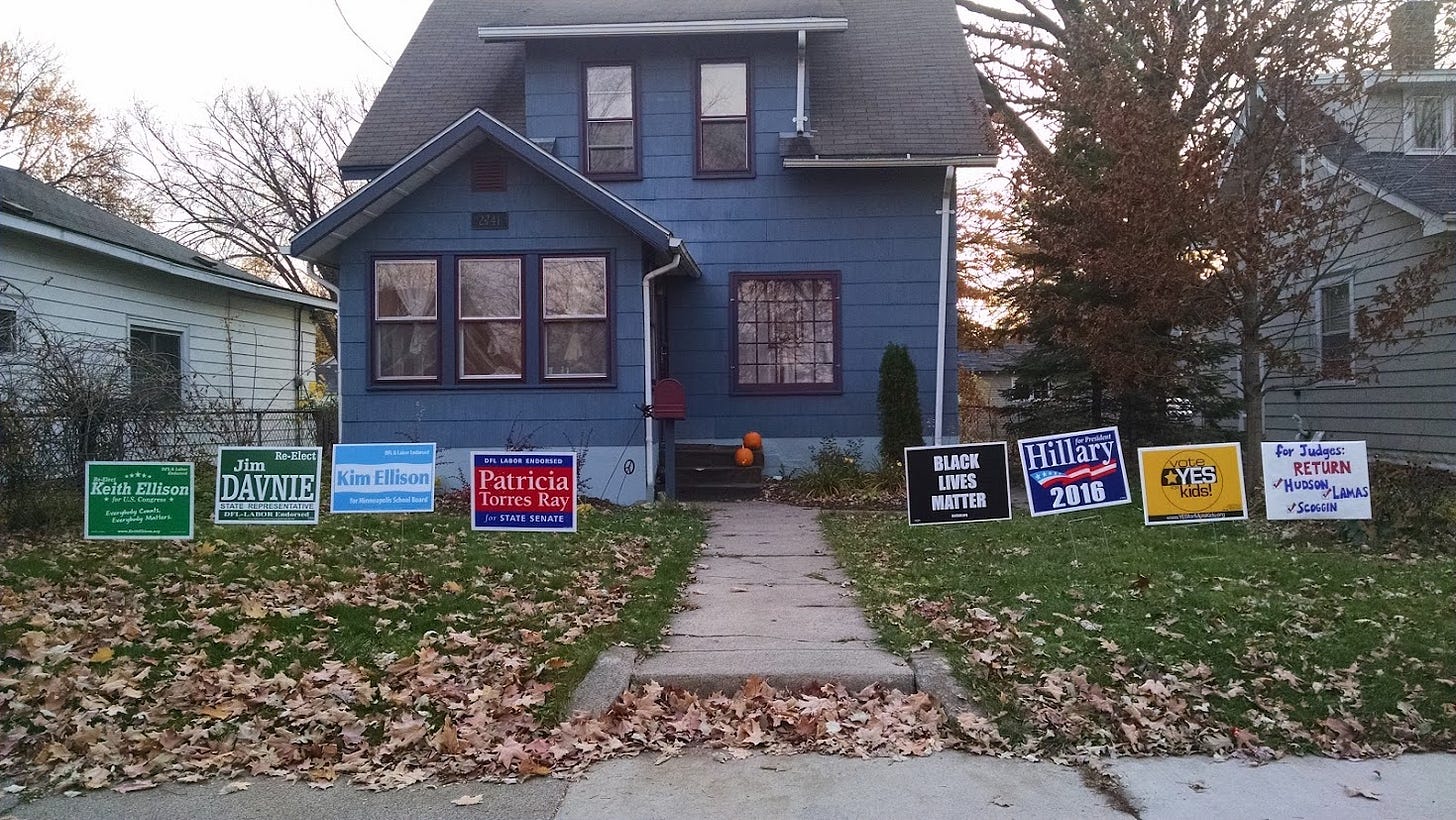The Making of a Blue City Warrior
Part Two of Blue City Warrior Visits Red America: In Search of Us
This is the second part of my series Blue City Warrior Visits Red America: In Search of Us. Go HERE to read the Blue City Warrior opening essay. Please subscribe to follow my journey!
Both of my deepest identities – as a Blue voter and as a city lover – stem from my childhood, and the time and the community that I grew up in.
I was born in 1964, one day before the U.S. Senate passed the 1964 Civil Rights Act, and much of my childhood was influenced by it and the changes it instigated in the country. By the time I arrived on the scene as the fourth child of Irv and Rosemary, my family was living in South Minneapolis. It was a lush neighborhood with many kids on the block. We were Black, white, Catholic, Jewish, single moms, and a number of Scandinavians, and almost everyone participated in the regular games of kick ball and capture the flag. When Dr. Rev. Martin Luther King was murdered in April 1968, the nearby park where my mom was on the parents’ council was renamed after him. And soon after that, a group of neighborhood parents began to advocate to the Minneapolis Public School Board to “pair” two local elementary schools to create the first intentionally integrated classrooms in Minneapolis. After successfully fighting a lawsuit to stop it, the plan received final approval, and in the fall of 1971 – after two years of attending Field Elementary School for Kindergarten and 1st grade – I was bussed to Hale Elementary School to start 2nd grade.
We also lived within walking distance to the stuff we needed: the grocery store, a Dairy Queen, the bus stop, the dentist, and more. Because Minneapolis is built on a plan that has a city park within 6 blocks of every home, there are a number of city parks within reach by foot and by bike. And of course the lakes and parkways were our playground, with summers spent tanning ourselves in baby oil at one of the several nearby lakes. After my parents got divorced in the mid-1970s, I started to get my lunches for free at school, and was old enough to start earning money by delivering papers from the paper shack just a few short blocks away. This was the era of Minnesota political giants Hubert H. Humphrey and Walter Mondale, both standard bearers of a liberal vision of America that advocated civil rights and a government that helped people.
As I grew up and my exposure to more people, neighborhoods, and cities expanded, I began to recognize that not everyone nor all communities had access to the same public goods that I enjoyed and benefited from. I especially noticed that my skin color also gave me better access to places and opportunities. The reverse was also true, that people with different skin color had different experiences, and were given less grace when walking through the world. I saw this disparity in opportunity and grace by skin color throughout high school, into my college years, and then as I moved into the working world.
One experience early in my career exemplifies how my whiteness got me privileges throughout my life. I was pushing up against a submission deadline and arrived at the post office just after the midnight deadline to get it postmarked. My only alternative was to hand deliver it to an office downtown, inside a building that was probably locked and had a lot of security presence. I snuck into the building behind someone who had a key and headed straight for the elevators. One of the security guys did a little “ahem” and asked me where I was going. I told him I was just heading up to an office to slide my proposal under the door. He not only let me by, but became my accomplice, accompanying me past locked doors and elevators to the office door. If I were Black or brown I likely never would have made it through the front door.
Through these experiences, I developed an understanding that not everyone has access to the same opportunities in life, that fortunes can be earned, but are more likely a result of the family that one was born into, where they lived, and the access that gave them to make a life for themselves. I see how systems – the policies, rules, laws, and social conventions – establish how things work, and elevate the fortunes of some people over others. And that these seemingly race neutral systems have very real and visible disparate impacts on people and communities by race.
This awareness, matched with my belief in the inherent dignity of all people and that we are all held in common bond with each other, gives me sympathy for my neighbors, both known and unknown. In turn, I’m led to support public policies aimed at those that may need a leg up because of racial and economic inequality and lack of access to resources. I’m also inclined to support investments in common goods, spaces, and places that everyone can access, regardless of their wealth or station in life. Generally, these are policies that tend to be supported by Democrats.
So that explains why I am a Blue voter, but growing up where I did also set me up to be a city lover.
After I graduated from high school, I moved away from the lush and well-resourced neighborhood of my youth. Yet I always looked for the same amenities wherever I landed. I fell trapped in places where I need to have a car to get anywhere I want to be, so I like living in places where I can get around by bike, foot, or public transit. I like living in places that facilitate informal interactions with others – whether I know them or not, the kinds of interactions that bind you to humanity, and give you a little dopamine shot as you travel through your day, or maybe even give you a new perspective on an issue you’ve been struggling with. I like living in a place that has good public spaces, where people can gather to enjoy a concert, or a movie, or a Saturday morning Farmers Market – space that is well taken care of and tells the world that the community cares about us being together. And I love living in a place where it is easy to get to the places you need to get to: work, a grocery store, the kids’ school, the post office, the gym and health care providers, and of course, nature.
I also love how living in cities exposes me to so many people. People that have different life experiences than I do, who are just living their lives, out in the open, and showing other ways of being in the world. It activates my brain and helps me to feel alive.
And I really love just walking down a block, whether it’s a place that is familiar to me or one that I am exploring for the first time, and trying to figure out how that place came to be the way it is. Why is the town where it is? Is there any unique geography that made it a good place for humans to live and gather? What individual events or historical trends impacted it to develop and grow the way it did?
At some point in my life, I moved back to my hometown, started my career (“career” - LOL), fell in love, got married, raised a couple of great humans. And I made some explicit decisions about where I wanted to live while I did those things. While it’s not New York City or Paris, the neighborhood I’ve called home for nearly three decades combines a lot of the things I desire. We live across the street from a city park that draws kickball leagues, parents with their kids at the playground and wading pool, and summer events including movies in the park. We’re just blocks away from the Mississippi River, where within minutes we can be immersed in trees and chirping birds, watching eagles and other raptors soar across the open water.
While we do own cars to get around, our home’s address is a “Biker’s Paradise” according to BikeScore. We can access the bike trails that make Minneapolis one of the best cities for biking, despite the great northern weather. And our home address’s walk score of 74/100 reflects our proximity to stores, coffee shops, public schools, and public transit. In fact, the area’s transit system is installing an ABRT line along our main street that will give us 10 minute service all day. I love to see the investment in public transit infrastructure so close to my house.
It’s not just the physical infrastructure that makes our neighborhood great, it’s also (most of) the people. The local liquor store owner gives away t-shirts every spring, with the same logo, just different colors. It’s one of the ties that binds our community together. I wear one of the > a dozen I own all the time, and give a knowing glance when I pass someone else wearing one too. Our neighborhood’s Buy Nothing group got so big that it had to divide up into four smaller areas. When Minneapolis went through the aftermath of the police killing of George Floyd in the early days of the pandemic, the community pulled together to protect each other.
And our neighborhood is engaged in elections. Like really engaged. While I know some of my neighbors vote Republican, most of the lawn signs reflect a more progressive bias: “Black Lives Matter”. “Abortion is Health Care”. “I love my Muslim Neighbor”. “Vote No Twice”, or “Vote Yes on Two”. And of course, signs for whoever the Democratic candidate is for whichever race is on the ballot in any given year. The voting results also show a progressive bias. Our senate district is one of the bluest in the state, with a penchant for sending people, often women, of color, immigrants, and borderline socialists, into office. (In fact, I lost my own race for city council years ago to the Green Party candidate who went on to serve four terms and eventually lost his seat to a Democratic Socialist of America candidate. Ha!) Our turnout drives Democratic victories for state-wide candidates, and has helped Minnesota deliver its electoral votes to the Democratic Presidential candidate every presidential election except one since 1960.
I live in a blue bubble, and I generally love it.
However, even though I love my community, I recognize that the trend of Americans sorting themselves into red and blue communities is harmful to our ability to understand each other, and that it’s contributing to the deep divisions ripping our country apart.
As we are in the midst of another brutal Presidential race where each side attempts to dehumanize the other, I find myself becoming more and more interested in getting out of my bubble. Don’t get me wrong. I know who I’m voting for and why. But I want to put myself in a red bubble where people default to assuming I’m a conservative Republican rather than where I live now where the opposite is true.
As I embark on these travels, I hope to not only learn about a few new places in the world, but also demystify red spaces – and the people who inhabit them. I want to see how red cities and the people who live in them might approach things differently than my community does. And learn how we might do things the same. I expect to learn some things – about myself, about others, and most importantly, about us together.
Subscribe to follow my journey!







